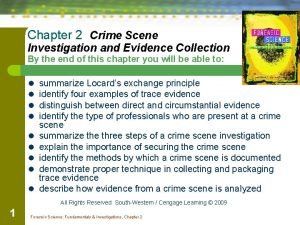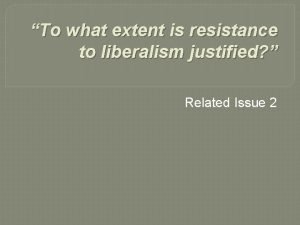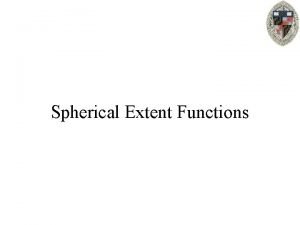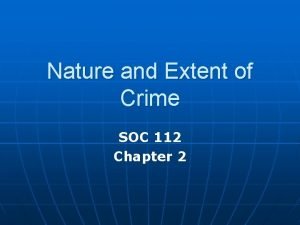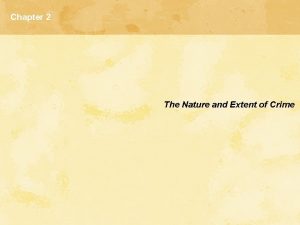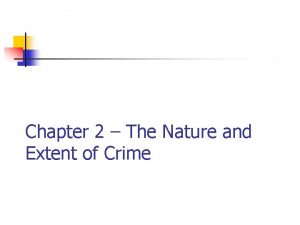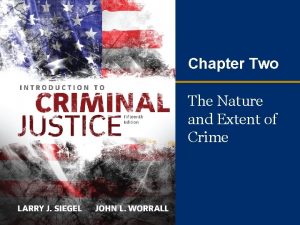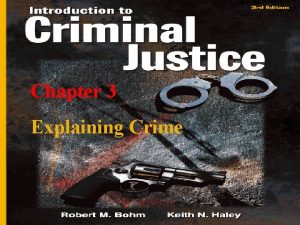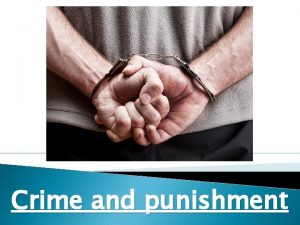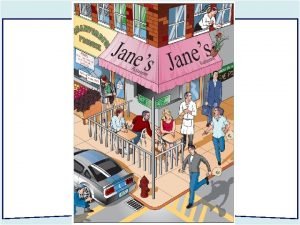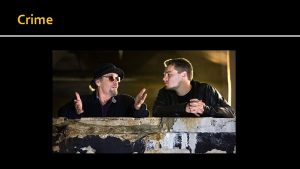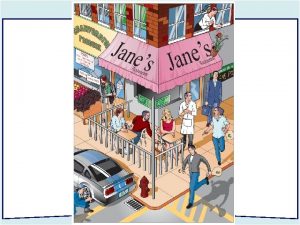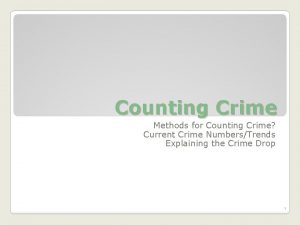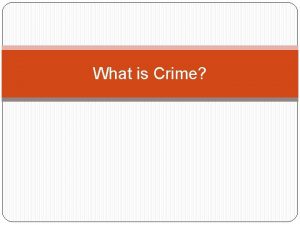Chapter 3 The Nature and Extent of Crime




























- Slides: 28

Chapter 3 The Nature and Extent of Crime Criminology 8 th Edition Larry J. Siegel © 2003 Wadsworth Publishing Co.

QUESTIONS How would you evaluate the effectiveness of America’s criminal justice system – “tough” or “lenient? ” Does the system fail in the apprehension and prosecution of criminals? Or, Will there always be a certain “going rate” for crime?

THE “GOING RATE” OF CRIME n The going rate is affected by fifty-one separate jurisdictions. n The going rate is often misjudged because of contradicting data. n The going rate varies as justice systems adapt to significant changes, i. e. , policy changes and work load changes.

QUESTION What is the funnel effect of the criminal justice system? What is the weakest link in the criminal justice system? And, Why is it the weakest link?

Methods of Measuring Crime Uniform Crime Reports Self- Report Surveys Victim Surveys

Uniform Crime Reports n Based on crimes reported to the police. n Based on a population unit of 100, 000. n Divided into two representative categories: Indexed and non-Indexed. n Categories counted differently. n Many problems with accuracy.

Problems With UCR Data n No federal crimes are included n Reports are voluntary – vary in accuracy and completeness. n Not all police departments submit reports n Only the most serious crime is recorded n Definitions of crimes vary

Uniform Crime Reports n Indexed Crimes ¨ Criminal Homicide ¨ Forcible Rape ¨ Robbery ¨ Aggravated assault ¨ Burglary ¨ Larceny/theft ¨ Motor vehicle theft ¨ Arson Violent Crime n Non-Indexed Crimes ¨ All others Non-violent Crime

The Future of the Uniform Crime Reports n National Incident-Based Reporting System (NIBRS) n Maintained by the F. B. I. n Twenty-two crime categories n More information on each crime in each category n Data compiled based on incidents, not arrests.

CLEARANCE RATE The clearance rate for crimes is when at least one person is arrested, charged, and turned over to court for prosecution. Of all crimes reported to the police, 20 -21 percent are cleared by arrest. (50 % for violent crimes and 18% for property crimes).

CRIMES CLEARED BY ARREST, 2000

CRIME RATE The crime rate is computed by the number of crimes reported to the police. Number of Reported Crimes x 100, 000 = Rate per 100, 000 Total U. S. Population

CRIME VICTIM SURVEYS n Asks victims about their encounters with criminals. n Uses sampling techniques. n May also describe people most at risk. n Potential measurement problems include: 1) Over and Under reporting 2) Sampling Errors 3) Inadequate question format 4) Inability to record activity

QUESTIONS What is the National Crime Victimization Study? What are some findings of the NCVS? What are some methodological problems?

Self Reported Crime 4 Participants reveal information about their violations of the law 4 Helps to get at the “Dark Figure of Crime” 4 Supplements and expands official data 4 Validity and reliability better than expected by many 4 Accuracy for chronic offenders and drug abusers may be limited

QUESTIONS What is the “dark figure of crime? ” Do you question the accuracy of self-report surveys?

CURRENT CRIME TRENDS Current data from the Uniform Crime Reports and the National Crime Victim Surveys reveal a steady decrease in crime. Self-reported data reveals no discernable change in the rate.

Trends in Violent Crime n n n Violent crimes in 2000 were the lowest since 1985 Violent crime was down 25. 5% since 1996 Current decline seems to be stabilizing 1986 2000

Trends in Property Crime 10. 2 million in 2000 -down 21. 4 % from 1991 -Rate of decline is stabilizing 1991 2000

Self Reported Criminal Activity Trends and Victimizations n Data indicates that the number of people who break the law is far greater than official statistics n Offenders seem to engage in a “mixed bag” of crime and deviance n The decline in victimizations parallels changes in the official crime rates.

Explaining Crime Trends Some of the important critical factors that have been used to explain the puzzle of crime rate trends n n n Age The economy Social malaise Guns Abortion n n Gangs Drugs Social-legal change Justice Policy Crime Opportunities

Crime Patterns Are there any “main” traits and patterns in crime statistics that can help us understand causation? AGE GENDER ECOLOGY CRIME SOCIAL CLASS RACE

Longitudinal Birth Cohort Research that tracks an identifiable group of individuals over a long period of time. What are some of the advantages of this kind of research? Disadvantages?

QUESTION What is the concept of a chronic or career offender? Who is most susceptible to this type of behavior?

The “Chronic 6%” After following a birth cohort of 9, 945 boys born in Philadelphia in 1945, Wolfgang and his associates found that 6% of the total sample were responsible for 51. 9% of all offenses. These were referred to as chronic offenders or career criminals. Similar research has resulted in similar findings.

Continuity of Crime THE COHORT FOLLOW-UP CLEARLY SHOWS THAT CHRONIC JUVENILE OFFENDERS CONTINUE THEIR LAW-ABIDING CAREERS AS ADULTS.

Implications of the Chronic Offender Concept n Traditional theories of criminal behavior have failed to distinguish between chronic and occasional offenders. n Why do some continue on in crime while others do not? n If we can identify chronic offenders, what should we do about them before and/or after they commit an offense?

QUESTION Do you think a “three strikes and you’re out” policy has an effect on chronic offenders?
 Nature of juvenile delinquency
Nature of juvenile delinquency Nature and nature's law lay hid in night
Nature and nature's law lay hid in night Nature nature controversy
Nature nature controversy Chapter 7 deviance crime and social control
Chapter 7 deviance crime and social control Locard exchange principle
Locard exchange principle To what extent has canada affirmed collective rights?
To what extent has canada affirmed collective rights? Was the british empire the biggest
Was the british empire the biggest Non contrived study setting
Non contrived study setting Extent
Extent To what extent should we embrace globalization
To what extent should we embrace globalization Should internationalism be pursued
Should internationalism be pursued To what extent has canada affirmed collective rights
To what extent has canada affirmed collective rights Should nation be the foundation of identity
Should nation be the foundation of identity Apush essay prompts
Apush essay prompts To what extent should we embrace nationalism
To what extent should we embrace nationalism Is resistance to liberalism justified
Is resistance to liberalism justified Which bird can rotate its neck backwards to a large extent
Which bird can rotate its neck backwards to a large extent To what extent has beowulf remained an epic hero?
To what extent has beowulf remained an epic hero? Noncontrived
Noncontrived To what extent can a damaged brain reorganize itself
To what extent can a damaged brain reorganize itself To what extent adverbs
To what extent adverbs Wide extent
Wide extent Dictionary managed tablespace
Dictionary managed tablespace Analyse the extent
Analyse the extent Glycogen is found to only a limited extent in
Glycogen is found to only a limited extent in Hát kết hợp bộ gõ cơ thể
Hát kết hợp bộ gõ cơ thể Frameset trong html5
Frameset trong html5 Bổ thể
Bổ thể




